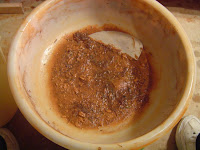Carolina Clay: The Life and Legend of the Slave Potter Dave
By Leonard Todd - a decendent of Dave's "owner"
The life of the slave potter Dave unfolds against a backdrop of cruelty, repression, war and unexpected tenderness in this intimate history. Little is known about Dave, whose stunning stoneware vessels are made more exceptional by the fact that he often inscribed verses, usually rhymed couplets, into their wet clay during the era when literacy among blacks was illegal and brutally punished.
My take on the book:
Loved it! Although, not quite what I expected. I expected this to be about Dave and how he made his large, stoneware pots. Actually, very little was said about his or the potteries' processes of which they made their pots - although it does go a little bit into the kiln they used, but at this point, who cares! I learned so much more than I would have imagined. I was gently guided into the life of a slave who broke the rules by writing on his pots! Rules? I mean Laws!
This potter also made pots with only one leg on a kick-wheel, and you'll never guess how. Because he wanted to? Maybe. Because he had to? Yes. This book gives you a rare glimpse into the life of a slave before, during and after the Civil War. A slave under several different owners. It is also a rare glimpse into the world of the potteries of Edgefield, NC, which I loved reading about. Makes me want to go there to check out the place. This book also gives you a little glimpse into the politics of the Civil War and Slavery, which will leave you wondering why most 'Blacks' these days are Democrats instead of Republican.
For the potter, this is a great historical read, for the collector, this is a must read, and for all the other readers, this is an interesting read that you will learn something from.

























